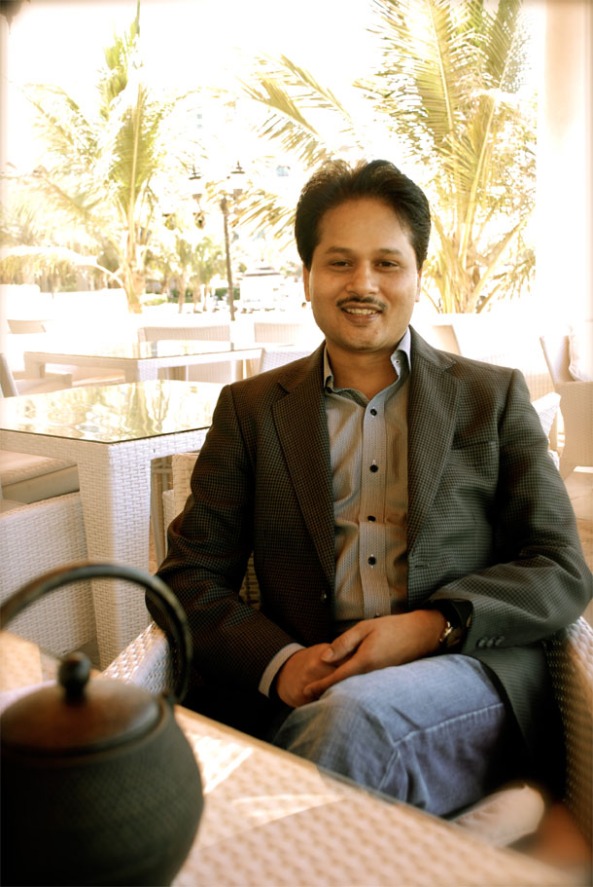
Molecular Gastronomy or ‘Food under Surgery’?
A few days back, I attended a demonstration session on Molecular Gastronomy conducted by Chef Matthias Mittermeier from SOSA. SOSA is one of the leading manufacturers of premium Molecular Gastronomy Ingredients. Molecular Gastronomy, also termed as the modern style of cooking or the Avant-Garde European Cuisine, is practiced by both scientists and food professionals in many professional kitchens and labs. Here, cooking takes advantage of the technical innovations in various sciences and is a sub-discipline of food science that seeks to investigate, explain and make practical use of the physical and chemical transformations of ingredients that occur while cooking, as well as the social, artistic and technical components of culinary and gastronomic phenomena in general (more on Wiki). 
I felt as if I was in a futuristic sci-fi kitchen in a laboratory, where ingredients with names like Maltosec and Isomalt – all popping out of cans as jellies and powders and going into various cooking ‘equipment’ requiring ‘techniques’ and ‘temperature control’ and ‘time measurement’! The above image shows making of spiced mandarin jelly spaghetti, in the SOSA session that I attended, held in The Emirates Academy Of Hospitality Management. Though, I was fascinated with the entire concept, I concluded that I am a taker for spluttering of oil, chopping the actual fruits and vegetables, feeling them under the running tap water, taking in their aroma as I load them into my basket in the supermarket, panting Oophs and Aahs as the gravy starts sticking into the pan and all the melodramatic nonsense associated with the verb Cooking. For me, this was Food under surgery, if the aroma had to be blown into the dessert through a tube. For me, the food that was cooked, didn’t have soul. I didn’t care much for what some described as a Culinary Art.
Intrigued, fascinated and confused, I set out on my quest to learn more.
There is no denying that Molecular Gastronomy is a fascinating concept. On my quest to learn more on the subject, I’ve done the following 3 things so far –
1) Dined at a restaurant called La Degustation in Prague, where the Czech menu is an interpretation of the refined culinary school of Marie B. Svobodová from the late 19th century. The restaurant has been claimed by Anthony Bourdain as The restaurant. A very different take altogether on fine-dining based on Modern Gastronomy. If a dollop of cheese dipped in mint (above) can taste like what I’ve tasted and presented like an art on canvas, then I had to give this Culinary Art a second chance!
2) Read FERRAN, the biography of Ferran Adrià, the head Chef of El Bulli. El Bulli has been voted to be one of the world’s best restaurants and the Menu has been created taking nuances from Molecular Gastronomy. (FooDiva tells me that Ferran Adrià detests the terminology Molecular Gastronomy and prefers to call this cutting edge cuisine. She suggests that I read FERRAN when I go ballistic over my idea of ‘Food Under Surgery’ on my Facebook Page.)
3) Sent a request to Chef Abhijit Saha saying that I wanted to meet him. Caperberry, his acclaimed restaurant in Bangalore, is based on a unique view of Avant-Garde European Cuisine where the pursuit for perfection is aided by the integration of culinary arts with culinary science and culinary artistry, achieved by a judicious mix of traditional and modern scientific cooking techniques and equipments with conventional and New Age ingredients.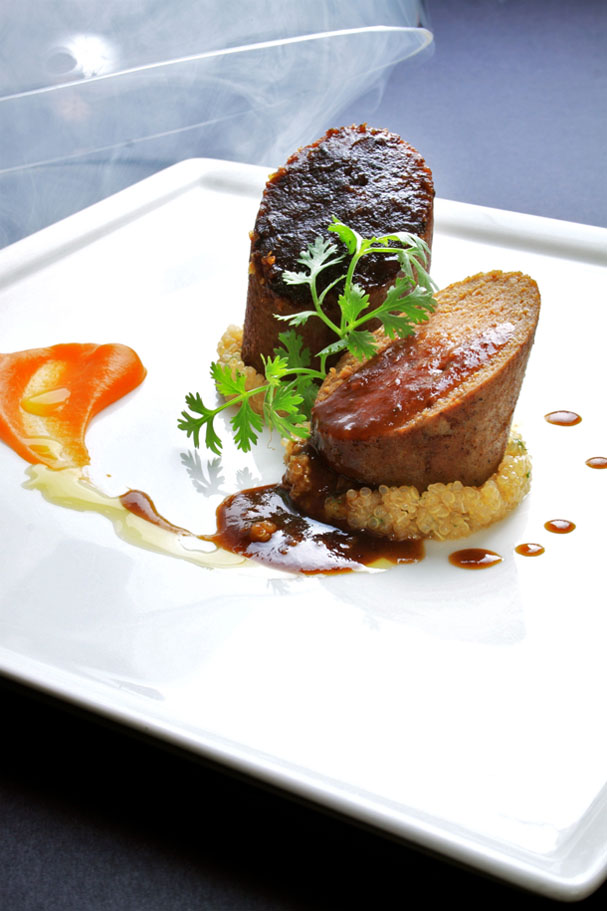
If you see the food image above, (Chef Saha shared this when I requested for a dish cooked in his signature style – his eagerness to share his knowledge is perhaps as strong as my eagerness to learn more on this subject), you’ll understand my restlessness in going deeper into the subject. Food looking as good as this must have some heart and soul in it. This is Sous Vide Cooked, Gilouti flavoured Smoked Lamb Roulade flavoured with Kakori Spices with Quinoa Risotto and Date Chutney, a signature dish served in Caperberry and cooked using Molecular Gastronomy techniques.
Chef Abhijit Saha, a man with a formidable list!
– Amongst one of the ’50 Most Influential Persons’ of Bangalore, according to India’s premier newspaper DNA
– Amongst one of the ‘Top 10 chefs in India’ by Outlook magazine
– Member of the voting panel for the London based ‘Restaurant’ magazine’s annual list of ‘Top 50 Restaurants of the World’
– Member of the elite team of chefs from across the world selected to participate in the ‘World Culinary Arts’ DVD which has won the ‘James Beard Foundation’ award
– Youngest to be featured in the coveted ‘Hall of Fame’ list of ’50 most important people in the Food and Beverage business in India’, published by the UpperCrust Magazine
An expert in Classical and Modern European and Indian cuisines; he has studied Oenology (Scientific Study Of Wines) and has a detailed understanding of old and new world wines. He is currently President of The Bangalore Wine Club and Corporate Chef (Marketing) for Indian Federation of Culinary Association. The list goes on… you can read more here. 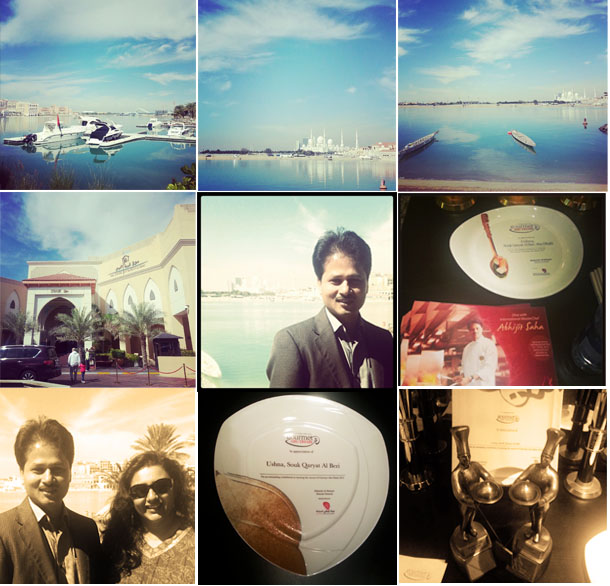
I met up with Chef Abhijit Saha in Ushna, at Souk Qaryat Al Beri, Abu Dhabi. He’s one of the International MasterChefs attending Gourmet Abu Dhabi 2013. Here’s our conversation –
You are almost in all lists – top 10, top 50, the best… too many lists and it’s pretty intimidating!
In life, you never plan things to be on a list. You have to love what you do. You’ve to be passionate, apply yourself, work hard – there are no short cuts. When you do all of these things right, use some common sense – everything else happens. The lists that you are talking about, should be a result of the work that you do and not vice versa. You work because you love the job, you love to cook, you love the business of Food. Cooking is only one part of the story. But how do you manifest your vision with the team of people around you to deliver that vision. You may have multiple restaurants in different countries one day, but to ensure that the vision is implemented across the board is very important.
So what should be the vision?
Your own style is your vision. And that style is – whatever you have set out to do, whatever standards you’ve set for yourself and whatever you have in mind while trying to create a dish. I find status quo very boring. You have to learn new things all the time, update yourself with new technology, re-invent yourself – no matter how old you are. You cannot just rest on your past laurels. I believe that the best is yet to happen and have to keep on striving for the better with utmost sincerity so that you can relate to your customers and your team.
Everybody who’s been to Caperberry believes that dining there is an experience. Do you try hard to create this experience?
Caperberry doesn’t serve run of the mill food. When you do things in a different way, it requires a lot of effort. I focus only on one thing – How do you want to surprise and delight your diners? To convert a regular dining into an experience, you have to do things differently. For a diner who walks into a restaurant, it’s not just about eating food. He’s also seeking variety of other things. Although, we do have a fixed menu (in India, you need to have a fixed menu) there are also Tasting menus, Food Festivals (for example – Mushroom Festival!), Guest Chefs coming in – you have to keep on doing new things to be on ‘top recall’ for a diner.
Fine-dining always has a fear factor associated with it, it can be intimidating for many – the wine lists, the food pairings etc. You don’t intend to take gourmet or fine-dining to the larger sections of people?
We’ve done this with Fava (his other restaurant in Bangalore with Mediterranean all-day dining restaurant and wine lounge, with private dining facilities and a delicatessen counter), where the ambiance is more Bistro-like. It is inclusive not exclusive, though the food served is presented in a different format and is very exclusive.
The Chef’s job In India has now become very fashionable. There’s a WOW factor to it. What would you contribute this to?
First and foremost, this is an interesting profession for sure. Secondly, it is being packaged well. Does Master chef Sanjeev Kapoor have any contribution here? I’m sure with the longest running food show on Indian Television, Sanjeev Kapoor has a lot to do with presenting the image of a Chef in India. Having said that, there are several factors contributing to this. Interaction with food has increased so much. The level of understanding and awareness of food has also increased in India due to international travel. Various ingredients are available and so many different types of restaurants have opened up. When you are so aware of food you want to try out different types of food. You are no longer happy eating the food that you are used to on a regular basis. Nowadays, all families go out to eat at-least once a week, specially in the urban areas. There are so many international channels on Television showcasing food and there is so much media coverage on Chefs. In fact, the kids today are also so much tuned into Food and Cooking.
In India where diners are used to Indian cuisine, opening up a Tapas Lounge or a restaurant serving international flavour, is a novelty. But now that you are outside India and if you set up a restaurant here, is the menu going to be like Caperberry’s or it is going to be based on Indian Cuisine and the regional variation? Will you bring in the Avant-Garde technique of cooking – presenting Indian food differently?
If I am looking forward to an international restaurant, it has to have my name on it. And I will create a new signature style, the showcase of which is being done in Ushna (the award-winning Indian restaurant at Souk Qaryat Al Beri, Abu Dhabi). This will usher in a new style of Indian food that I want to present internationally, in all it’s glory. The richness of Indian food comes from several heritages, including home-cooking. You still have so many homes where cooking is done on a daily basis and imagine the quantum of knowledge that has accumulated over so many years. With a civilisation as old as the Indus Valley Civilisation, the various influences from the different foreign invasions, a rich legacy, so much of variety in terms of culture, climate and geography, it’s long coastline – it’s incredible what is possible.
Again, coming back to my favourite question, almost a clichéd one now – Yes, it’s incredible what can be done and although Indian Food is very popular, I feel sad that the regional cuisine has never been showcased. Internationally, Indian Cuisine had always confined itself to a few North Indian dishes – Chicken Tikka, Chicken Butter Masala and the Biryani or else the South Indian Dosas, Idlis and Vadas.
I am going to showcase regional Indian cooking presented in the contemporary manner, as well as cooked in the Avante-garde technique. I have taken inspiration from traditional dishes from different regions and then present it in a different style or a format so that it confirms to certain international standards of style. I’m maintaining the regional names of the dishes. (From the Menu – Bengali Seabass Curry, Dhuyen Ka Murgh Korma, Pashmina Chicken Supreme Kebab and many more).
Is this something you are trying here for the first time?
I used to run an Indian Restaurant called Saffron in The Park Hotel, Kolkata for 4 years. I did a lot of work in Saffron that was contemporary and based on modern cooking. Working as a Chef in Indian Hotels, has given me many opportunities to be in touch with Indian cuisine. Moreover, we also have bespoke catering where we do cook Indian food. My touch with Indian food has always been there. Probably, the time needs to be right for me to open an Indian restaurant.
Coming to Molecular Gastronomy, I’ve attended a session on it which made me feel that I was in a Science Lab. The food that came out was perfect. I felt something was missing…
The heart and the soul is missing? Molecular Gastronomy is not a cuisine. It is a collection of cooking techniques. Like boiling, roasting etc. These are very contemporary cooking techniques that have developed over the past 20 years by understanding the science behind it. It is sometimes used in the Food Industry. How does the cookies come out so crunchy from a packet? Or how does the Potato Chips turn out to be the way it is? Many of the techniques have already been used before and many are being created by understanding the science behind cooking – what are the chemical changes that the ingredients undergo when you are cooking them. How do you apply these techniques in traditional cooking, to make the food innovative and create an experience for your diners – the essence of traditional cooking will be there and yet it will be contemporary. I will be demonstrating all these in my Master class (at Gourmet Abu Dhabi 2013).
It is not a Molecular Gastronomy Cuisine as such, but style of cooking developed in Molecular Gastronomy, i.e. Avante – Garde Cuisine which refers to pushing the boundaries, being innovative, being experimental. So you do not have to have an Indian restaurant that is based 100% on Molecular Gastronomy. If there is a technique you can use from Molecular Gastronomy to enhance the flavour, the quality or the presentation of the dish, then we’ll do that. So there is no question of not having any warmth in any dish. Even in Caperberry, the Menu is not 100% based on Molecular Gastronomy. We’ve taken the traditional and modern European cooking, applied techniques of Molecular Gastronomy, to create innovative dishes.
You’ve studied so much – the old wines and the new wines, ancient and modern European Cuisine – what has been the motivation behind this? (he has studied Hotel Management in Pusa, New Delhi and Oenology at the Johnson and Wales University, USA. Subsequently he has toured France, Italy, Spain, California and Australia for a detailed understanding of old and new world wines. He is a Founding member of Wine Society of India and member of Chaine des Rotisseurs, Paris.)
One has to evolve and one has to do new things all the time. Why should I cook if cannot do it in a new way? It has to be exciting. I used to be an Italian Chef for such a long time that opening an Italian restaurant was the most obvious thing to do. But when I opened my restaurant, it was more Spanish! Ultimately, it’s also my life and I have to do things that teaches me something, I can learn new things every day and excites my sensibilities, challenges my intellect and caters to my emotional needs as well. I feel that a day is wasted if you haven’t learnt anything on that day.
Do you think that this Caperberry experience is working in a city like Bangalore because it has got a huge expat population. But it might not work in other Indian cities or say in places like Dubai and Abu Dhabi which already have many ‘exciting’ dining options?
Ultimately, food has to taste good, feel good, look good and satisfy the diner at end of it. When Food is presented on a plate, it should look good and ultimately it should be delicious. That’s the whole essence. It doesn’t matter how you arrive at that – whether it is street food, whether it is Indian cuisine or Spanish Cuisine. According to Harold Maggi, Molecular Gastronomy is ‘study of deliciousness’. One needs to ask at the end of the day – ‘Does it taste good?’ and it doesn’t matter what cuisine and which part of the world you are opening up a restaurant. It has to find place in the heart of the customers. There is a formula for a good restaurant and a bad restaurant but there is no formula for a successful restaurant.
It is a very urban trend nowadays to visit a New restaurant, probably because of more disposable income, exposure to new culture etc. How does an existing restaurant cope up with the constant ‘re-inventing’ of one’s self?
The market has to be sustainable. And one has to keep connected to the customers all the time. You have to market yourself well, organise festivals, invite Guest Chefs. It is becoming more and more challenging for existing restaurants as new restaurants are proliferating. But I feel that it’s good that new restaurants are opening up and can probably cater to a particular area that hasn’t been catered to before. That’s the way the world evolves.
I am all for technology if it doesn’t ruin our lives. I keep on studying about restaurants and Chefs, specially the Indian scenario and I think that there’s no other restaurant in India that has invested so much in kitchen technology as your restaurant has. Did you get introduced to these things? (the expenditure and the cost of setting up his spanking ‘green’ kitchen is staggering – INR 3,000,000/ or AED 24,000/- approximately for a Sous Vide – a kitchen gadget, which slow cooks meat, seafood and even vegetables at a precise temperature incorporating the latest of techniques!)
Everyday when you get up it’s a new day, isn’t it? (I burst out laughing!) Everyday I like to refresh myself, rejuvenate and re-think. I get new thoughts and ideas, get inspired from my travels. I like to keep in touch with the world of innovations. But, to incorporate these things in daily restaurant life does increase the cost of operations in the long run, isn’t it? Yes, it does. I like to work with a good team. A Chef is as good as it’s team. So we have a high man-power cost. We work with the best equipment and ingredients so that the team also feels proud to be doing something new all the time. There are certain high costs associated with keeping up with the whims and fancies of a Chef!
There are many young Chefs who read my blog, what do you have to say to them? They might have started their careers as a passion but now they are just doing their jobs and feel they are stuck in a rut!
The first 10 years of your life, you need to work very hard, learn everything in a focused manner and do things differently. The foundation has to be very strong. If it is about chopping the onion or peeling the garlic, then be a master in that and start thinking different. But then not everyone can be an Entrepreneur? Everybody doesn’t have to be an Entrepreneur. I wasn’t an Entrepreneur even 4 years back. Today’s Chefs have such a wonderful opportunity to explore the world – go around different countries, learn from different cultures. Maybe 2 years in the Caribbeans, 2 years in France and so on.
Do you ever think that the Master Chefs can come up together to build up a Culinary Academy in India on the lines of French Cooking Schools?
Yes I have. There is not a single culinary institute that teaches Indian cooking – to either the Indian students or the International students who want to learn about Indian Cuisine. I want to do that. You have the Le Cordon Bleu for French cooking or you have the ICIF for Italian cooking. But as I speak, some Indian Chef must be thinking of setting up an academy of the highest International standards.
When will Michelin come to India?
Michelin, the body doesn’t feel that there is a quantum of a good number of Indian restaurants for them to come to India. For Michelin to set up in India, there has to be a certain level of cooking and quality that has to be prevalent across the large section of restaurants, then it makes sense for them to come. It is not only about home-grown Indian restaurants but also about International Chefs finding India to be a destination to open up their Michelin-star restaurants. Michelin is a very European concept. It’s only 3 years that they have come to Singapore, 4 years in Japan and 5 years in America. For India, there is still time. I am expecting that 5 years down the line, Michelin would be setting up a body here. Is Michelin-star restaurant a fashionable thing or does it genuinely define the quality of the restaurant? There is a certain evaluation scheme and does define the image of a restaurant. It also means that the quality of the restaurant is of a certain level. I myself would be interested in getting one if Michelin comes to India. (There are stories that if Michelin comes to India, Caperberry will be the first to get a Michelin!).
And finally, my favourite question – Do you read Food Blogs? Do you think that Food Bloggers have an important role? Do you think this way – we already had Food Critiques, why again a Food Blog?
Unfortunately, I do not have the time to read as much as I would love to. If someone finds Food fascinating and writes about that, what is the harm? Each person had a different perception of Food. It also depends upon individual preferences. Everybody has their own right to write about Food.
◊—————————————————————◊
You can experience an Epicurean dining with Masterchef Saha (11-14 February, 2013) and an exclusive set menu on Valentine’s Day at Ushna, at Souk Qaryat Al Beri, Abu Dhabi as a part of Gourmet Abu Dhabi 2013. For reservations and for more details, please call +971 2 558 1769.
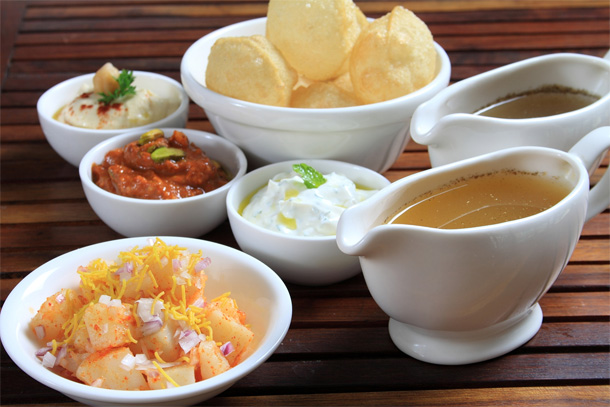
You can have the Preview of the Menu here, while the following images are enough to knock me down. A sneak preview of Indian food cooked up with Avante-garde techniques that will be served by Chef Saha. These Indian makeovers can only be created by a maverick! For example, the Gol Guppas above with Hummus or Tzatziki (an ode to my love for Kolkata Phuchkas) or the Curry Leaf Seared Foiegras with Kokum Saar (chilled Kokum and Coconut broth, Cinnamon roasted Apple and Apricot Chutney), the Bengali Seabass Curry (Home ground Mustard paste, Green chilli and Turmeric sauce; Crispy Straw potatoes) or the Assorted Spherifications below (with Jal Jeera/Cumin water; Mango Lassi; Tomato Rasam/Tomato & Curryleaf flavoured broth). And these are just a few of the vast menu that Chef Saha will be showcasing.
A shame that I won’t be able to attend his dinner as I am travelling. I can only imagine the kind of crispiness that can be achieved by Molecular Gastronomy when the Crispy Straw potatoes will be served with the Seabass Curry. This must be the jhurjhure Aloo bhaja that accompanies a Bengali meal.

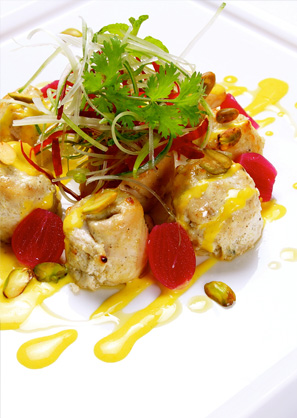
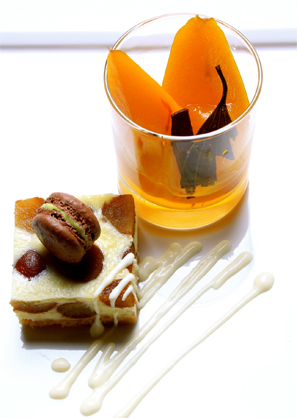
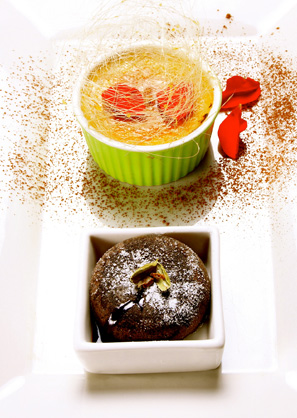
◊—————————————————————◊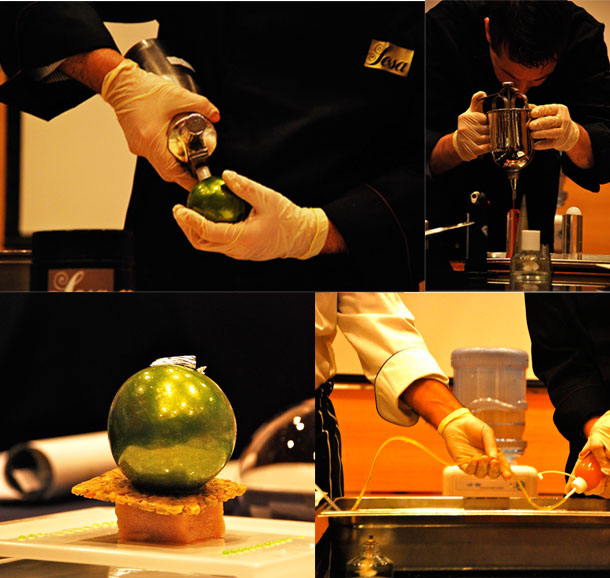
Discussing Molecular Gastronomy with Fooderati:
After attending the SOSA session (above), I was very intrigued and we had a very interesting debate and conversation amongst my foodie friends in Fooderati Arabia (a passionate and a serious group of UAE food bloggers) – some of them had attended the SOSA session with me. The discussion is as follows:
 Marta of Marta’s Kitchen: I love it! I think it is a very, very interesting topic and I find fascinating to discover how certain elements react when combined with others. For example, Maltodextrin, which comes from Tapioca (absolutely natural), has the ability to absorb all fat and reduce any fatty product to a sort of sand or powder! wow!! Molecular Gastronomy is fascinating!
Marta of Marta’s Kitchen: I love it! I think it is a very, very interesting topic and I find fascinating to discover how certain elements react when combined with others. For example, Maltodextrin, which comes from Tapioca (absolutely natural), has the ability to absorb all fat and reduce any fatty product to a sort of sand or powder! wow!! Molecular Gastronomy is fascinating!
Francine of Life in the Food Lane: I did do two posts on molecular cooking: one based on a demo in Marta‘s kitchen. It looks at what you need for your molecular pantry, explains more about the techniques and additives used. I do find it intriguing. Slow food for me… here’s my posts – A Recipe For Fun with Molecular Cooking and the link to my post looking into the background of molecular gastronomy, more of a theory post and musings: Musings on Molecular Gastronomy.
Rebecca of epicurUAEn: Many chefs and professionals no longer use the word molecular gastronomy, but modern gastronomy. The use of the word molecular is only a marketing tool to explain the techniques easily and on the other hand, for some to start a debacle to separate it from traditionalists. I think, in certain cases it helps to make it more exciting and to demonstrate the detail to attention involved. The chefs still very much do their chopping, boiling, tasting in the kitchen and what you saw is just a condensed demonstration of the techniques. No ingredient ensures good taste, freshness or emotions automatically – this is the same with modern gastronomy, the chef still needs to wow with their know how and expertise. Hope that helps!
Stacy of Food Lust People Love: I felt much like you did, Ishita. It was fascinating but I am not sure of the applications for a home cook. This is fancy stuff and gorgeous, to be sure, but I daresay it requires equipement and expertise that I don’t have. The one thing that I thought where I would use this in home cooking, were the essential oils. If only they came in smaller quantities! That said, I was very happy that I attended the demonstration. The “star” chef’s enthusiasm for the potential of the products was infectious. And his artistic skills blew me away!
Debbie of The Real Geordie Armani: Interesting, but I am more a cook like Grandma did kind of person
Sally of My Custard Pie:I wanted to attend this as I feel very ‘anti’ this whole area and wanted to see if finding out more confirmed or contradicted my prejudices. Couldn’t make it sadly. Interesting to hear your view.
Swati of Swati Bansal Rao: My thoughts are exactly the same. I am intrigued by this modern way of cooking but not yet there. I love more of rustic and traditional cooking. Perhaps, one day, when I am more familiar to this new way of cooking.
Marta: As Rebecca said, it is not about doing a whole meal based on this, but using some elements to enhance your traditional and delicious dish!
Mitzee of The World according to Mitzee Mee: Here’s my link – Molecular Gastronomy: From the lab to the kitchen
Samantha of FooDiva: This subject fascinates me… if you fancy a good read, try Ferran Adria’s bio – he detests the term molecular and prefers ‘cutting edge cuisine’.
◊—————————————————————◊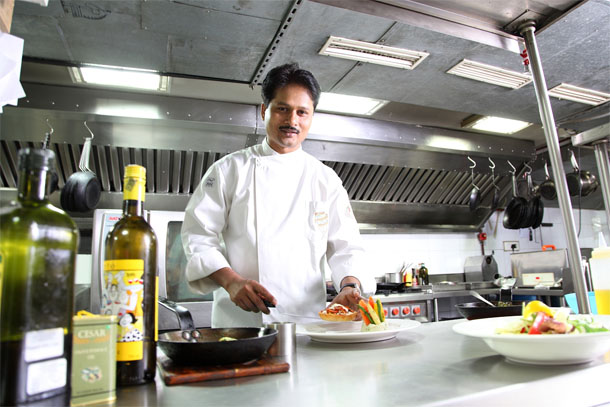
A Bengali hailing from Siliguri, a city in North Bengal with schooling in the picturesque Himalayan town of Kurseong, and turning into a Delhi boy only later in his life, this man has no regular day at home. Running a successful business with no frown lines has earned him the title of the ‘Young Chef – Abhijit Saha’. If only people sharing the same surname could genetically possess the same vigour and the same virtues, then I’d have been a very happy lady!
I’m very (secretly) proud of this Bengali Chef who loves his Chingris/Prawns and Aloo Postos/Potato with Poppy Seeds and Mishtis/Sweets, (overtly) proud of this Indian Chef and (supremely) proud of this International Masterchef who’s keen to take Indian Cuisine to a different standard with new age technology. Molecular Gastronomy is not just ‘food under surgery’ after all and one can breathe life, heart and soul into it – there’s probably a formula to it. And talking about formulas, apart from the kitchen, the other thing that probably excites Chef Saha is Formula 1. Infact, he is going to drive a F1 on the Valentine’s Day – a Valentine’s gift from Abu Dhabi Tourism board. Had Big Z been there, she would have definitely screamed – ‘Lucky You!’
Unblogging it all… Ishita
Disclaimer: The food images and the image of Chef Saha in the kitchen were sent to me when I wanted to showcase some Indian food cooked with Avante-Garde technique. I hope you enjoy reading the posts with lot of visuals but please do not use any material from this post. You can see more pictures of my travel and food journey here.
◊—————————————————————◊
References:
Molecular Gastronomy in Wikipedia


Oh my what a wealth of info here! So reading between the lines is Chef Abhijit opening a restaurant here? Interesting to see he also does not refer to the cuisine as molecular gastronomy but preferring the term avant-garde. If you’re after more on MG in Dubai, the closest you will get to here is Pierre Gagnaire’s Reflets at Intercon Festival City – he’s in town next month for the LitFest. Oh and also check out Chef Stephane’s FB page (Exec Chef of the Westin) used to run Tang here where he tried to transplant his New York MG concept here but for many reasons the restaurant closed down. https://www.facebook.com/pages/Stephane-Buchholzer-cuisine/
LikeLike
And I should say ‘what a wealth of info ‘ in your comment – had tweeted you, but am now replying to you properly. Thank you FooDiva:) Will check out on these for sure. Always love your suggestions and have so much to learn anyway.
LikeLike
Pingback: Chef Sanjay Bahl | Flavours And Flavours And Flavours of Patiala! |
Pingback: I Saw Them Cook And I Ate What They Cooked | Taste of Dubai 2013 |
Pingback: Asha Bhosle | Cooking With Her, Listening To Her & Sharing Her Recipe! |
Pingback: Chef Violet Oon | The Singaporean Food Guru & Her Recipe Of Chilli Crab! |
Pingback: Feteer Meshaltet In Video | Talking To Celebrity Chef Joe Barza |
Pingback: Dynamite Shrimp For Breakfast And Talking To Philip Chiang | P.F. Chang’s |
Hi Abhijit ,
Nice to read ur blog .My daughter who is in class x is interested in moleculer gastronomy. Could u please guide her as to what subjects should she take up in intermediary school and what further higher education is required to excel in this area.
Kindly send me ur email id. for future correspondance .
Awaiting ur reply .
LikeLike
HI
I am not a Chef But I am passionate about cooking and want to do something different in my Life
LikeLike